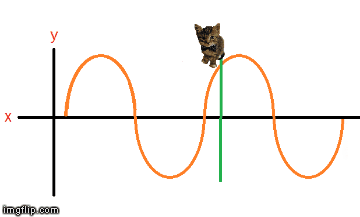.....lets have quick recap on the main behaviours waves have. In this post we'll look at the two best known:
Reflection:
Waves bounce off things, and we call it reflection... but there's a little bit more to it than that: In two dimensions, or three, waves follow a law of "angle of incidence equals angle of reflection" (the law of reflection). To make it easier to see the law of reflection in diagrams we often use ray diagrams (explained in this post). Drawn with a ray diagram the law of reflection looks like this:

When doing calculations we will almost always use ray diagrams, but it's important to remember that light actually moves in waves. A good way of visualising reflection with waves is using a ripple tank with a light behind - so the shadows of the waves are projected onto a screen. Sainnt Mary's University show this nicely:
When we combine reflection with phase and interference (see this post) we can get some unexpected phenomena, such as standing waves.
Refraction:
Let's go back to our equation that relates wave speed, frequency and wavelength (from this post):
...where V is wavespeed, f is frequency, lambada is wavelength.
One of the things that happens when a relationship binds quantities like these together is that when one of them changes, at least one of the others needs to change to maintain balance in the relationship.
And guess what? In refraction they change: When a wave passes from one medium to a different medium its speed changes - like a cats speed would change if swam from water into treacle.
 |
| You're planning me to do what?! |
The speed changes but the frequency does not (otherwise the light would change colour). Because it's speed is different but not its frequency the wavelength must change.That doesn't cause any complications when the wave hits the edge of the new medium straight on....
...but when it comes in at an angle this means that the wave fronts would be broken.....
...unless the angle of the waves changes. And, because the wave fronts don't like to be broken, the angle of them does change:
To make things a bit simpler we'll draw this out as a ray diagram (see here for a quick run down on ray diagrams)
There is a law that predicts how the angle of the rays change, called Snells' law. It uses a property that every medium has, called 'refractive index'. Refractive index determines how light moves through a medium. For example, empty space has a refractive index of 1, so light moves through it easiest, air as an index of 1.000277 and most glass has an index of around 1.5.
To use Snell's law we need to draw a line (called a 'normal' line) that is at right angles to the surface the rays are passing through, and measure the angles the incoming and refracted rays make to it. When we've done that, Snell's law is this:
Where:
Angle 1 = angle between the incoming rays and the line that is at right angle to the surface
Angle 2 is the angle between the refracted rays and the line that is at right angle to the surface
n1 = index of refraction for the material the light starts in
n2 = index of refraction of the medium the light ends up in
So, as well as direction, refraction changes wavelength and speed. But by how much? There're related equations that let us work out the change in wavelength and wave speed, using the angles the waves make to the normal line:
...Where:
V = wavespeed
Lambada = wavelength
Angle 1 = angle between the incoming rays and the line that is at right angle to the surfaceAngle 2 is the angle between the refracted rays and the line that is at right angle to the surface.
Practice Questions:
1: A ray strikes a reflecting surface at a 40 degree angle to that surface. What angle does the reflected ray make with the surface?
2: A ray passes through vacuum, then into a block of glass with a refractive index of 1.4. It strikes the glass at an angle of 45 degrees to the normal. What angle does it make with the normal beneath the surface of the glass?
3: The light from question 2 has a wavelength of 560 nanometers in the vacuum.
a) What is its wavelength inside the glass?
b)What is its speed inside the glass?
* I've mentioned before that a Physicist should have a touch of supervillian.

























